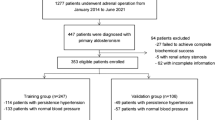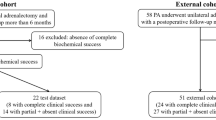Abstract
The Aldosteronoma Resolution Score (ARS) is the most studied scoring system for predicting the high likelihood of hypertension cure after adrenalectomy for unilateral primary aldosteronism (PA). However, the ARS’s accuracy in PA patients worldwide is uncertain. We aimed to perform a meta-analysis of the accuracy, discrimination, and calibration of the ARS using stratum-specific likelihood ratios (SSLR) by organizing available data from cohort studies. We searched PubMed, Embase (Ovid), the Cochrane CENTRAL, Web of Science to November 2021 according to PRISMA statement. The quality assessment used adapted TRIPOD and PROBAST criteria. Thirteen studies comprising 2158 PA patients from North America (43%), Europe (32%), Asia (22%), and other continents, were included. The pooled estimate of the area under the receiver operating characteristic curve for all studies was 0.77 (95% CI: 0.73–0.81), and the ratio of the observed to expected complete resolution of hypertension (CRH) for all studies was 0.9 (95% CI: 0.8–1.0). The summary estimates of the SSLR for all studies were 0.31, 0.89, and 3.1, for the low (ARS 0–1), medium (ARS 2–3), and high-likelihood group (ARS 4–5) of CRH, respectively. However, substantial heterogeneity existed among studies. Follow-up period, and adrenalectomy AVS (adrenal vein sampling)-guided served as potential sources of heterogeneity for quantitative studies, which were measurement and reference standard for qualitative studies selection. In conclusion, in patients with unilateral PA, the ARS is currently an accurate prediction tool, the easiest and cheapest, for identifying long-term high likelihood of CRH after adrenalectomy, particularly when the adrenalectomy is AVS-guided.
This is a preview of subscription content, access via your institution
Access options
Subscribe to this journal
Receive 12 digital issues and online access to articles
$119.00 per year
only $9.92 per issue
Buy this article
- Purchase on Springer Link
- Instant access to full article PDF
Prices may be subject to local taxes which are calculated during checkout


Similar content being viewed by others
Data availability
All data generated or analyzed during this study are included in this published article and its Supplementary Information Files.
References
Zhou Y, Zhang M, Ke S, Liu L. Hypertension outcomes of adrenalectomy in patients with primary aldosteronism: a systematic review and meta-analysis. BMC Endocr Disord. 2017;17:61.
Benham JL, Eldoma M, Khokhar B, Roberts DJ, Rabi DM, Kline GA. Proportion of patients with hypertension resolution following adrenalectomy for primary aldosteronism: a systematic review and meta-analysis. J Clin Hypertens (Greenwich). 2016;18:1205–12.
Marzano L, Colussi G, Sechi LA, Catena C. Adrenalectomy is comparable with medical treatment for reduction of left ventricular mass in primary aldosteronism: meta-analysis of long-term studies. Am J Hypertens. 2015;28:312–8.
Williams TA, Lenders JWM, Mulatero P, Burrello J, Rottenkolber M, Adolf C, et al. Outcomes after adrenalectomy for unilateral primary aldosteronism: an international consensus on outcome measures and analysis of remission rates in an international cohort. Lancet Diabetes Endocrinol. 2017;5:689–99.
Vorselaars W, Nell S, Postma EL, Zarnegar R, Drake FT, Duh QY, et al. Clinical outcomes after unilateral adrenalectomy for primary aldosteronism. JAMA Surg. 2019;154:e185842.
Kim RM, Lee J, Soh EY. Predictors of resolution of hypertension after adrenalectomy in patients with aldosterone-producing adenoma. J Korean Med Sci. 2010;25:1041–4.
Morisaki M, Kurihara I, Itoh H, Naruse M, Takeda Y, Katabami T, et al. Predictors of clinical success after surgery for primary aldosteronism in the Japanese Nationwide Cohort. J Endocr Soc. 2019;3:2012–22.
Burrello J, Burrello A, Stowasser M, Nishikawa T, Quinkler M, Prejbisz A, et al. The primary aldosteronism surgical outcome score for the prediction of clinical outcomes after adrenalectomy for unilateral primary aldosteronism. Ann Surg. 2020;272:1125–32.
Yang Y, Williams TA, Song Y, Yang S, He W, Wang K, et al. Nomogram-based preoperative score for predicting clinical outcome in unilateral primary aldosteronism. The Journal of Clinical Endocrinology & Metabolism, 2020;105:e4382–92
Zhang C, Wu L, Jiang L, Su T, Zhou W, Zhong X, et al. KCNJ5 mutation contributes to complete clinical success in aldosterone-producing adenoma: a study from a single center. Endocr Pr. 2021;27:736–42.
Wu CH, Peng KY, Hwang DY, Lin YH, Wu VC, Chueh JS. Novel mutations detection with next-generation sequencing and its association with clinical outcome in unilateral primary aldosteronism. Biomedicines. 2021;9:1167. https://doi.org/10.3390/biomedicines9091167.
Weigel M, Riester A, Hanslik G, Lang K, Willenberg HS, Endres S, et al. Post-saline infusion test aldosterone levels indicate severity and outcome in primary aldosteronism. Eur J Endocrinol. 2015;172:443–50.
Utsumi T, Kamiya N, Endo T, Yano M, Kamijima S, Kawamura K, et al. Development of a novel nomogram to predict hypertension cure after laparoscopic adrenalectomy in patients with primary aldosteronism. World J Surg. 2014;38:2640–4.
Wachtel H, Cerullo I, Bartlett EK, Kelz RR, Cohen DL, Karakousis GC, et al. Long-term blood pressure control in patients undergoing adrenalectomy for primary hyperaldosteronism. Surgery. 2014;156:1394–402.
Zarnegar R, Young WF Jr., Lee J, Sweet MP, Kebebew E, Farley DR, et al. The aldosteronoma resolution score: predicting complete resolution of hypertension after adrenalectomy for aldosteronoma. Ann Surg. 2008;247:511–8.
Utsumi T, Kawamura K, Imamoto T, Kamiya N, Komiya A, Suzuki S, et al. High predictive accuracy of Aldosteronoma Resolution Score in Japanese patients with aldosterone-producing adenoma. Surgery 2012;151:437–43.
Namekawa T, Utsumi T, Tanaka T, Kaga M, Nagano H, Kono T, et al. Hypertension cure following laparoscopic adrenalectomy for hyperaldosteronism is not universal: trends over two decades. World J Surg. 2017;41:986–90.
Pasquier L, Kirouani M, Fanget F, Nomine C, Caillard C, Arnault V, et al. Assessment of the Aldosteronona resolution score as a predictive resolution score of hypertension after adrenalectomy for aldosteronoma in French patients. Langenbecks Arch Surg. 2017;402:309–14.
Ebell MH, Walsh ME, Boland F, McKay B, Fahey T. Novel approach to meta-analysis of tests and clinical prediction rules with three or more risk categories. BMJ Open. 2021;11:e036262.
Page MJ, McKenzie JE, Bossuyt PM, Boutron I, Hoffmann TC, Mulrow CD, et al. The PRISMA 2020 statement: an updated guideline for reporting systematic reviews. BMJ. 2021;372:n71.
Collins GS, Reitsma JB, Altman DG, Moons KG. Transparent reporting of a multivariable prediction model for individual prognosis or diagnosis (TRIPOD): the TRIPOD statement. BMJ. 2015;350:g7594.
Wolff RF, Riley RD, Whiting PF, Westwood M, Collins GS, Reitsma JB, Kleijnen J, and Mallett S, for the PROBAST Group. PROBAST – A risk-of-bias tool for prediction-modelling studies 2017 [Available from: https://abstracts.cochrane.org/2017-global-evidence-summit/probast-%E2%80%93-risk-bias-tool-prediction-modelling-studies.
Debray TP, Damen JA, Snell KI, Ensor J, Hooft L, Reitsma JB, et al. A guide to systematic review and meta-analysis of prediction model performance. BMJ 2017;356:i6460.
Kontopantelis E RD. Metaan: Random-effects meta-analysis. Stata J. 2010;10:395–407.
Snell KI, Ensor J, Debray TP, Moons KG, Riley RD. Meta-analysis of prediction model performance across multiple studies: Which scale helps ensure between-study normality for the C-statistic and calibration measures? Stat Methods Med Res. 2018;27:3505–22.
Simundic AM. Measures of diagnostic accuracy: basic definitions. EJIFCC. 2009;19:203–11.
Aronova A, Gordon BL, Finnerty BM, Zarnegar R, Fahey TJ 3rd. Aldosteronoma resolution score predicts long-term resolution of hypertension. Surgery 2014;156:1387–92.
Worth PJ, Kunio NR, Siegfried I, Sheppard BC, Gilbert EW. Characteristics predicting clinical improvement and cure following laparoscopic adrenalectomy for primary aldosteronism in a large cohort. Am J Surg. 2015;210:702–9.
Fujita N, Hatakeyama S, Yamamoto H, Tobisawa Y, Yoneyama T, Yoneyama T, et al. Implication of aortic calcification on persistent hypertension after laparoscopic adrenalectomy in patients with primary aldosteronism. Int J Urol. 2016;23:412–7.
He XQ, Yang S, Wu JL, Wang DL, Ren W, Cheng QF, et al. A Fisher discriminant model to predict the outcome of postoperative blood pressure in primary aldosteronism. Zhonghua Yi Xue Za Zhi. 2016;96:3379–83.
Vorselaars W, van Beek DJ, Postma EL, Spiering W, Borel Rinkes IHM, Valk GD, et al. Validation of the aldosteronoma resolution score within current clinical practice. World J Surg. 2019;43:2459–68.
Romero-Velez G, Laird AM, Barajas ME, Sierra-Salazar M, Herrera MF, Libutti SK, et al. Outcomes of adrenalectomy and the aldosteronoma resolution score in the black and hispanic population. World J Surg. 2021;45:1475–82.
Dominguez DA, Chatani P, Murphy R, Copeland AR, Chang R, Sadowski SM, et al. Contralateral suppression index does not predict clinical cure in patients undergoing surgery for primary aldosteronism. Ann Surg Oncol. 2021;28:7487–95
Weigel M. Kochsalzinfusionstest und subdifferenzierung und outcome des primären hyperaldosteronismus: analyse des deutschen conn-registers [Medical Doctor disseration]. http://d-nb.info/1075757495/34: Medizinische Fakultät Charité - Universitätsmedizin Berlin; 2015.
Lindhiem O, Petersen IT, Mentch LK, Youngstrom EA. The importance of calibration in clinical psychology. Assessment. 2020;27:840–54.
Zhou Y, Wang D, Jiang L, Ran F, Chen S, Zhou P, et al. Diagnostic accuracy of adrenal imaging for subtype diagnosis in primary aldosteronism: systematic review and meta-analysis. BMJ Open. 2020;10:e038489.
Rossi GP, Crimi F, Rossitto G, Amar L, Azizi M, Riester A, et al. Identification of surgically curable primary aldosteronism by imaging in a large multiethnic international study. J Clin Endocrinol Metab. 2021;106:e4340–9.
Author information
Authors and Affiliations
Contributions
Concept and design of the study: LM, CR. Literature research and clinical advice: LM, FHS, TR, CR, MZ. Acquisition, analyses, or interpretation of data: LM. Manuscript drafting: LM. Critical revision of the manuscript for important intellectual content: LM, FHS, TR, CR, MZ. Study supervision: TR, CR.
Corresponding author
Ethics declarations
Competing interests
The authors declare no competing interests.
Additional information
Publisher’s note Springer Nature remains neutral with regard to jurisdictional claims in published maps and institutional affiliations.
Supplementary information
Rights and permissions
About this article
Cite this article
Marzano, L., Husain-Syed, F., Reis, T. et al. Assessment of performance of stratum-specific likelihood ratios of the aldosteronoma resolution score for predicting hypertension cure after adrenalectomy for primary aldosteronism: a systematic review and meta-analysis. J Hum Hypertens 37, 532–541 (2023). https://doi.org/10.1038/s41371-022-00731-8
Received:
Revised:
Accepted:
Published:
Issue Date:
DOI: https://doi.org/10.1038/s41371-022-00731-8



